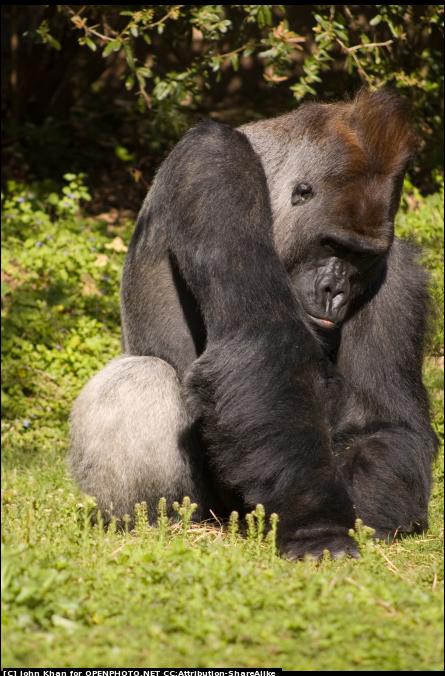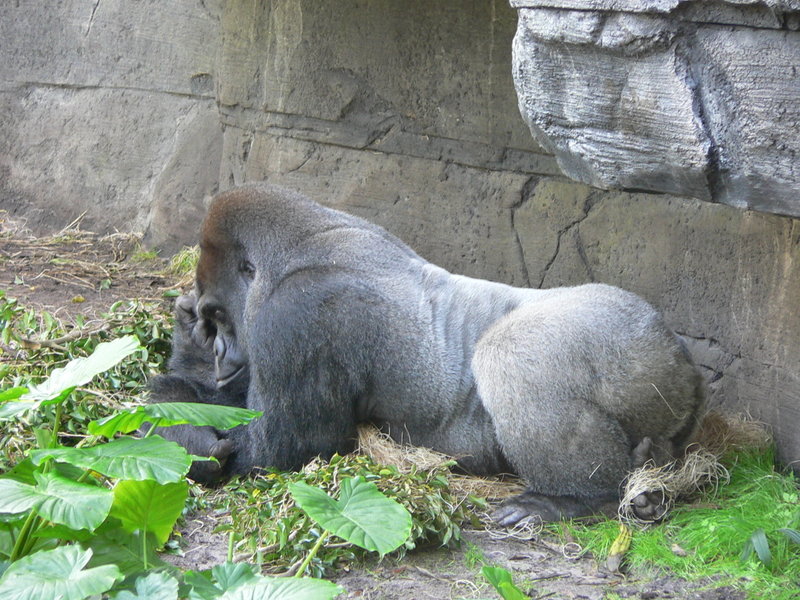The
Threat of Extinction...

Sadly, the future of
Western Gorillas looks grim, unless drastic changes occur very soon.
Several
factors are currently decreasing their numbers at a staggering rate,
including disease and human impact. In
the past two decades, the population of Western Lowland Gorillas has
been reduced by over 60% in the wild. This has led the International
Union for the Conservation of Nature and Natural Resources (IUCN) to
update the status of the species from "Endangered" to "Critically Endangered"
in its 2007 Red List of Threatened Species. The Cross River
subspecies, which has a population of less than 300, was added to the "Critically Endangered"
list previously. 9
The Ebola
Virus is currently decimating populations of Western Lowland Gorillas.
The virus, which also affects humans, causes gastrointestinal symptoms,
extreme fever, body pain, internal and external bleeding, and often
death within one to two weeks of symptoms appearing. Over 95%
of gorillas who become infected with Ebola die. An electron micrograph of Ebola virions is shown at
left. The virus was first detected in wild gorillas in 1994 and has
since swept through many protected populations, including those of
Odzala National Park in Congo. This park previously housed a higher
number of Western Lowland Gorillas than the rest
of Africa's Western and Eastern Gorilla
populations combined, but Ebola decreased the park's populations by
55%. Overall, Africa has seen the total population of protected Western
Gorillas decline by about a third in the past 15 years due to
Ebola alone. The virus could soon reach the remaining protected areas
of western Africa, unless a vaccine is implemented; several possible
Ebola vaccines have been researched and found to be effective in
monkeys, but further testing and funds are needed before vaccines can
be put to widespread use in wild gorilla populations. 9
of Ebola virions is shown at
left. The virus was first detected in wild gorillas in 1994 and has
since swept through many protected populations, including those of
Odzala National Park in Congo. This park previously housed a higher
number of Western Lowland Gorillas than the rest
of Africa's Western and Eastern Gorilla
populations combined, but Ebola decreased the park's populations by
55%. Overall, Africa has seen the total population of protected Western
Gorillas decline by about a third in the past 15 years due to
Ebola alone. The virus could soon reach the remaining protected areas
of western Africa, unless a vaccine is implemented; several possible
Ebola vaccines have been researched and found to be effective in
monkeys, but further testing and funds are needed before vaccines can
be put to widespread use in wild gorilla populations. 9
In the
past few years, other diseases that are known to affect humans have
also been found in Western Gorilla populations. In 2006, it was
reported that a new strain of simian immunodeficiency virus (SIV),
which is very closely related to HIV-1 group O, had been detected
in wild Western Lowland Gorillas. Previously, only chimpanzees were
known to carry strains of SIV similar to HIV-1, and no strains similar
to the group-O viruses had ever been detected in non-human primates.
Additionally, the first confirmed death of a gorilla due to anthrax
(caused by Bacillus
anthracis) was documented in 2005 in Cameroon.
Such diseases may play a significant role in wild gorilla populations
and need to be investigated further. 11,17
Human
activity also plays a major role in the plight of the Western Gorilla.
Human population growth causes settlements and agricultural practices
to push further and further into the forests of Africa. Timber
production in many areas of the gorilla's habitat experienced
a greater than two-fold increase between 1991 and 2000, leading to
deforestation and a large number of roads cutting across the previously
dense forests. These roads exacerbate the spread of diseases and
provide easy access for hunters. Gorillas are illegally hunted for their meat and
sometimes even for their body parts, which are used to make
"souvenirs." Logging groups tend to eat more of this "bushmeat" than
local natives and will often use their trucks to transport the
carcasses to cities, where the meat is increasingly being considered a
"gourmet" food. Since the Western Gorilla has a very low birth rate, any hunting is detrimental to the population. 9,18
To learn more about the bushmeat trade and what is being done to end
it, visit the Bushmeat Crisis Task Force and see
their interactive maps.
 Does the plight of the Western Gorilla frustrate you? Here are a few
things you can do to help them and their environment:
Does the plight of the Western Gorilla frustrate you? Here are a few
things you can do to help them and their environment:
1. Don't chose products made with
wood
logged from rainforests or
using
non-sustainable practices.18
2. Recycle your old cell phones. The
mineral coltan, which is used in cell
phones, is found in many areas
home to gorillas. Mining the mineral
destroys their habitat.18
3. When travelling abroad, do not eat
meat
from threatened species.
4. Encourage others to do the same!
--------------------------------------------------------------------------------------------------------------------------------------------------------------------------------------------------------------------------------------------------------------------------
Question
or Comments? Feel free to contact me at wussow.arik@students.uwlax.edu.
Site
designed by Arika Wussow, Last updated April 2008.
MultipleOrganisms.net
University
of
Wisconsin-La Crosse


 of Ebola virions is shown at
left. The virus was first detected in wild gorillas in 1994 and has
since swept through many protected populations, including those of
Odzala National Park in Congo. This park previously housed a higher
number of Western Lowland Gorillas than the rest
of Africa's Western and Eastern Gorilla
populations combined, but Ebola decreased the park's populations by
55%. Overall, Africa has seen the total population of protected Western
Gorillas decline by about a third in the past 15 years due to
Ebola alone. The virus could soon reach the remaining protected areas
of western Africa, unless a vaccine is implemented; several possible
Ebola vaccines have been researched and found to be effective in
monkeys, but further testing and funds are needed before vaccines can
be put to widespread use in wild gorilla populations. 9
of Ebola virions is shown at
left. The virus was first detected in wild gorillas in 1994 and has
since swept through many protected populations, including those of
Odzala National Park in Congo. This park previously housed a higher
number of Western Lowland Gorillas than the rest
of Africa's Western and Eastern Gorilla
populations combined, but Ebola decreased the park's populations by
55%. Overall, Africa has seen the total population of protected Western
Gorillas decline by about a third in the past 15 years due to
Ebola alone. The virus could soon reach the remaining protected areas
of western Africa, unless a vaccine is implemented; several possible
Ebola vaccines have been researched and found to be effective in
monkeys, but further testing and funds are needed before vaccines can
be put to widespread use in wild gorilla populations. 9  Does the plight of the Western Gorilla frustrate you? Here are a few
things you can do to help them and their environment:
Does the plight of the Western Gorilla frustrate you? Here are a few
things you can do to help them and their environment: